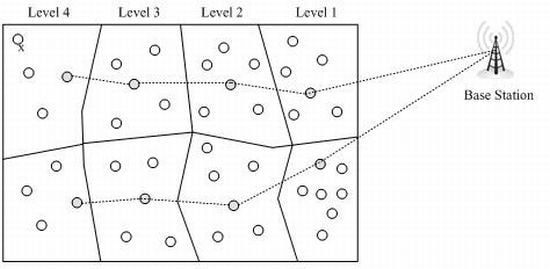Energy Efficient Routing in Wireless Sensor Networks Through Balanced Clustering
Abstract
:1. Introduction
2. Related Work
- The Setup Phase: In the setup phase, the clusters are organized and the cluster heads are selected. In every round, a stochastic algorithm is used by each node to determine whether it will become a cluster head. If a node becomes a cluster head once, it cannot become a cluster head again for P rounds, where P is the desired percentage of cluster heads.
- The Steady State Phase: In the steady state phase, the data is sent to the base station. The duration of the steady state phase is longer than the duration of the setup phase in order to minimize overhead.
3. The Proposed Protocol for Energy Efficient Routing in WSNs
3.1. Description of the Adopted Energy Model
3.2. Description of the Proposed Routing Model

- The BS creates a Time Division Multiple Access (TDMA) schedule and requests the nodes to advertise themselves, a process similar to that of other protocols.
- Each node broadcasts a message to advertise its energy level and location to its neighbors. Based on this exchanged information, each node sets up a neighbor information table that records the energy level and the positions of its neighbors and sends this table along with its corresponding information to its neighbors. This step is repeated until the information of all the nodes in the network is sent to the BS, allowing the BS to have a global knowledge of the network. At this step, all the nodes are cluster head candidates, and each node has a unique ID that is also included in the exchanged table.
- As soon as the node advertisement is completed, the BS runs the Gaussian elimination algorithm and computes the number of rounds at which every node can be a cluster head, trying to maximize the network lifetime. In the first step of the cluster head selection, the BS chooses the nodes closest to itself to be the high level cluster heads. Moreover, some of the nodes from which the BS has not received any direct advertisement message are considered to be low level cluster heads. The overall number of nodes, which are assigned to be cluster heads, is 5% of the total number of the nodes in the network, as this can be helpful in achieving good performance in a homogeneous network with various parameter settings [11]. Other percentages can also be used.
- The BS broadcasts the unique IDs of the newly selected cluster heads, and their cluster members and the nodes use this information to form and enter a cluster. Therefore, each node has the knowledge of the number of times that it can be a cluster head and the number of times that it cannot. The BS runs the Gaussian elimination algorithm and computes the appropriate number of rounds that the nodes can be cluster heads and sends this information to the nodes.
- The lower level cluster heads do not transmit directly to the BS. They use the upper level cluster heads as intermediate repeaters of their data to the BS.
- Each cluster head creates a TDMA schedule and broadcasts this schedule to the nodes in its cluster, in order to inform each node of the timeslot that it can transmit. Moreover, the radio component of each node is allowed to be turned off at all time periods, except during its transmission time. Therefore, the energy dissipation of every individual sensor is considerably reduced.
- Then, the data transmission starts. The nodes, based on the allocated transmission time, send the data concerning the sensed events to their cluster head. The transmission power of every node is adjusted to the minimum necessary to reach its next hop neighbor. In this way, both the interference with other transmissions and the energy dissipation are reduced.
- Every lower level cluster head aggregates the data and then transmits the compressed data to the upper lever cluster heads until the data reaches the base station. A round of data transmission has been completed, and the protocol continues from step 4 for the next round.
- In case that there is a change in the network topology, due to either a change in a node position or in the total dissipation of a node residual energy, the BS uses again the Gaussian elimination algorithm to determine the appropriate cluster head election
- The execution of the protocol is terminated as soon as all the nodes in the network run out of energy.

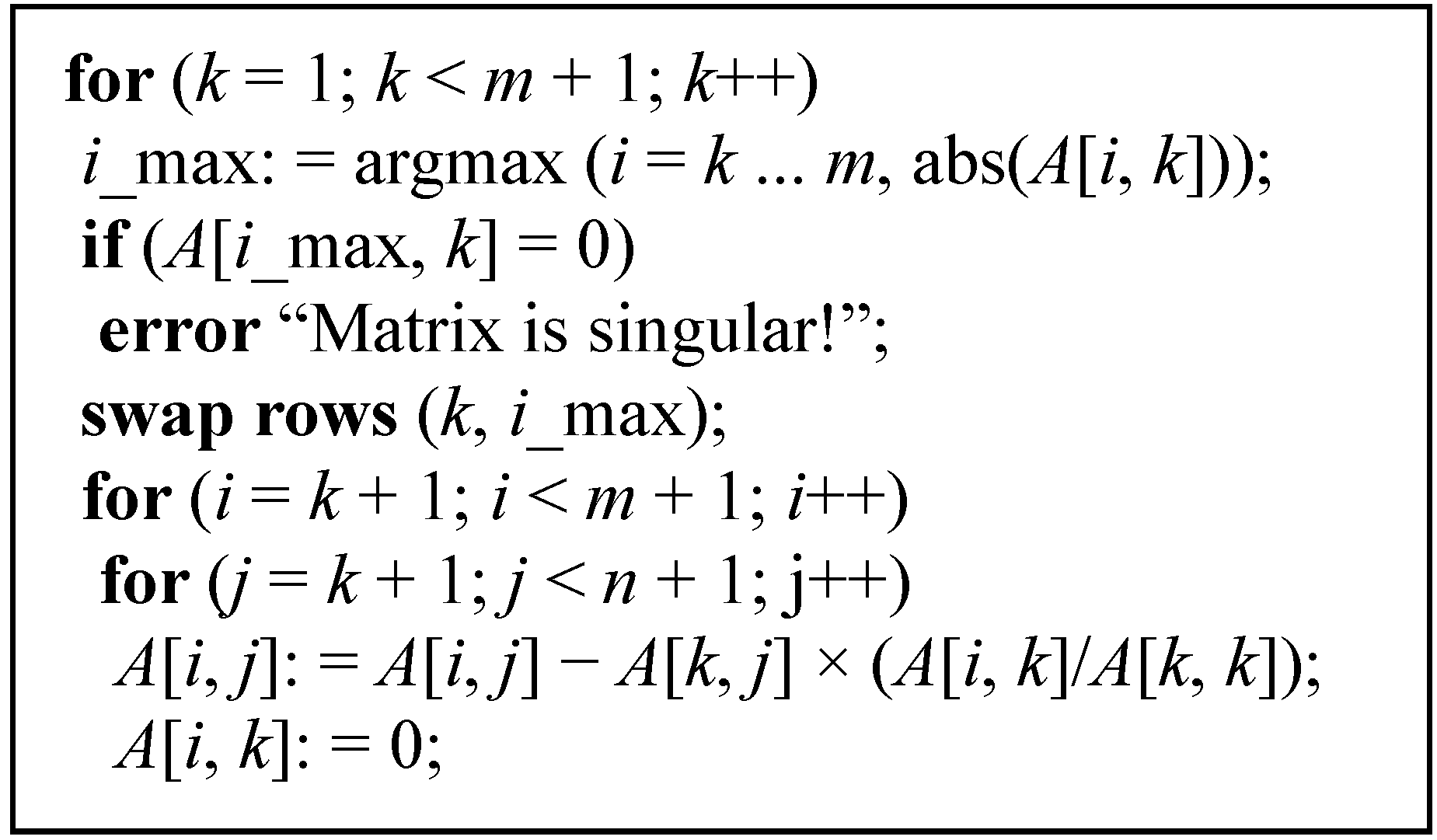
4. Performance Evaluation of ECHERP
- A fixed base station is located away from the sensor field.
- The sensor nodes are energy constrained with uniform initial energy allocation.
- Each node senses the environment at a fixed rate and always has data to send to the base station (data are sent if an event occurs).
- The sensor nodes are assumed to be immobile. However, the protocol can also support node mobility.
- The network is homogeneous, and all the nodes are equivalent, i.e., they have the same computing and communication capacity.
- The network is location unaware, i.e., the physical location of nodes is not known in advance.
- The transmitter can adjust its amplifier power based on the transmission distance.
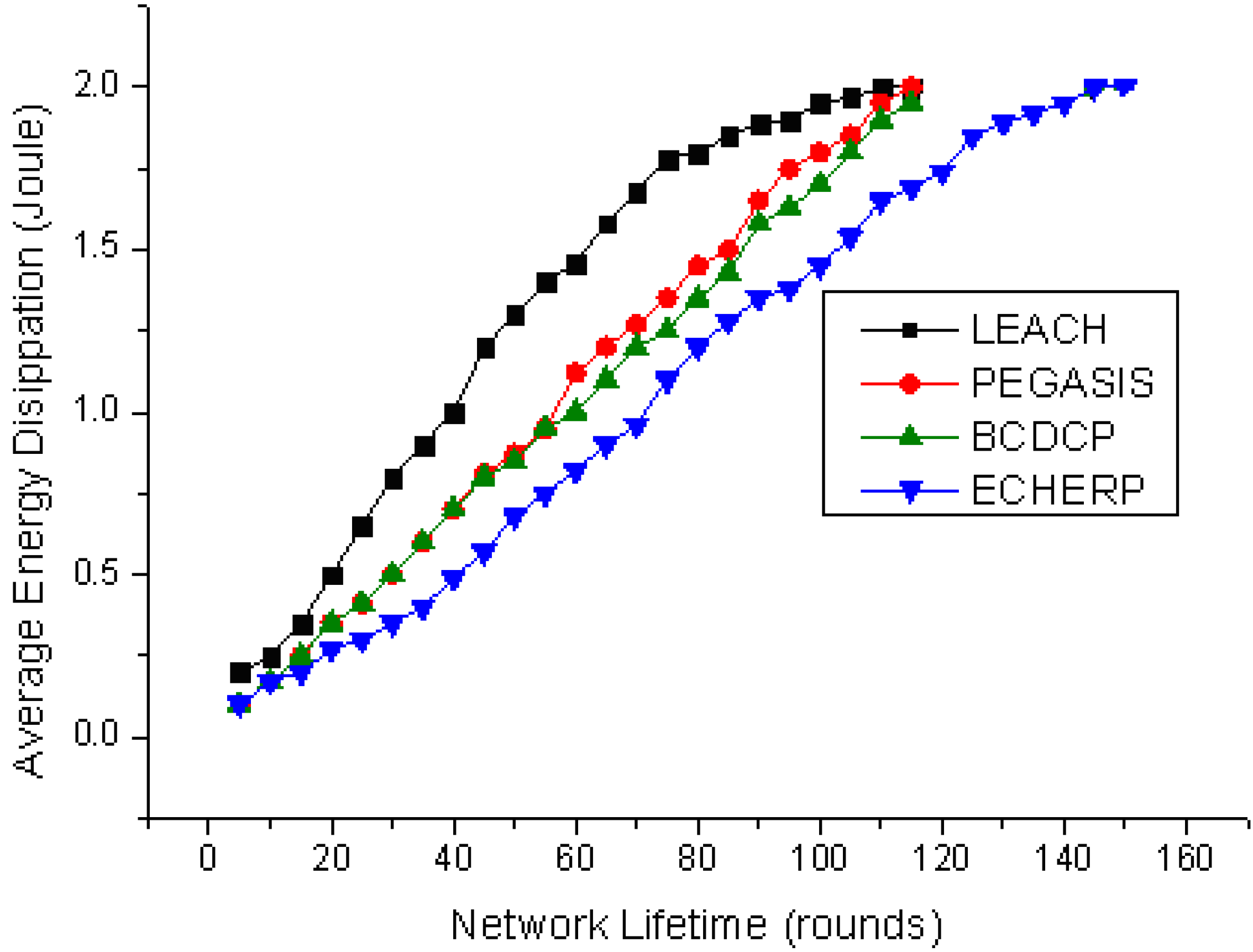
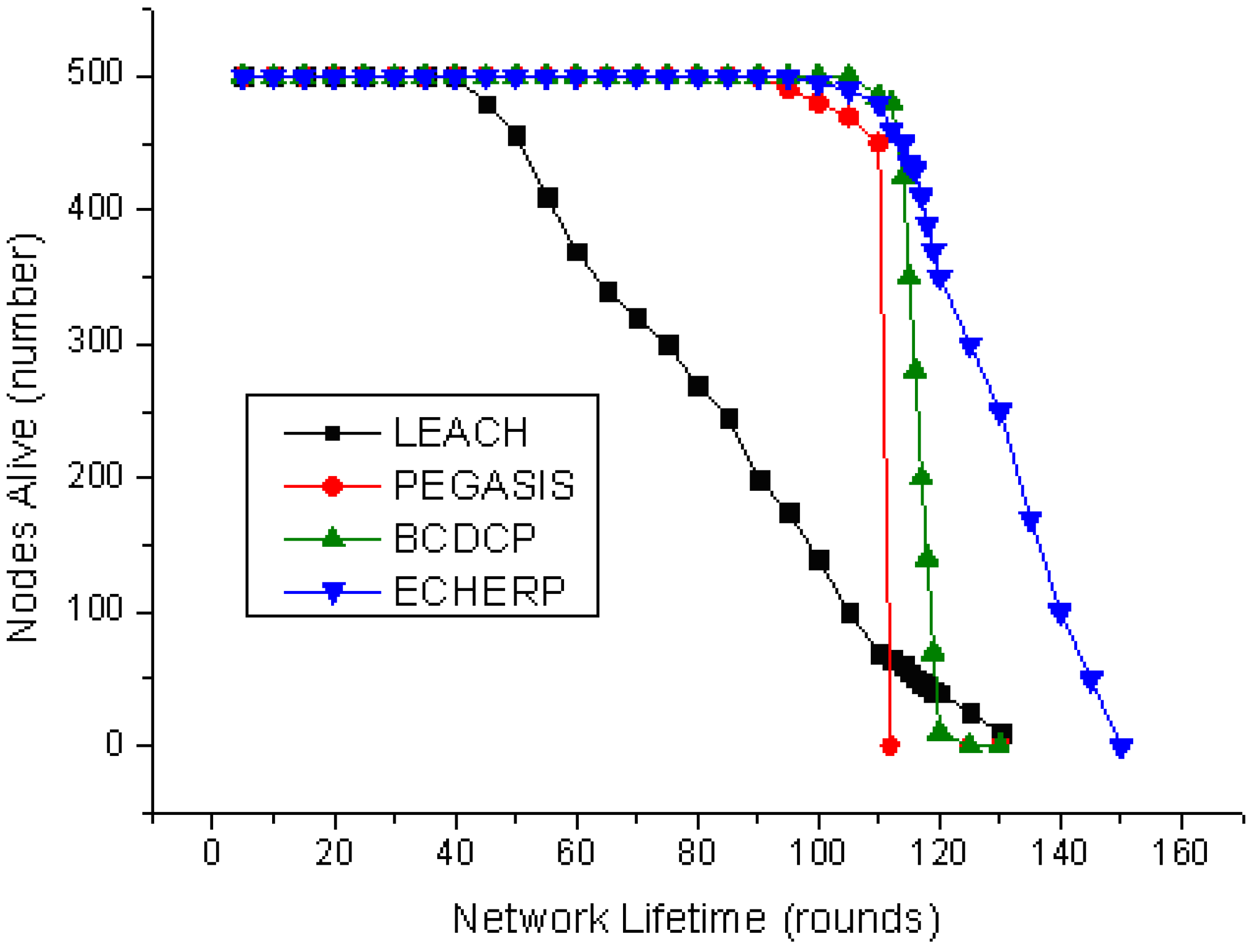

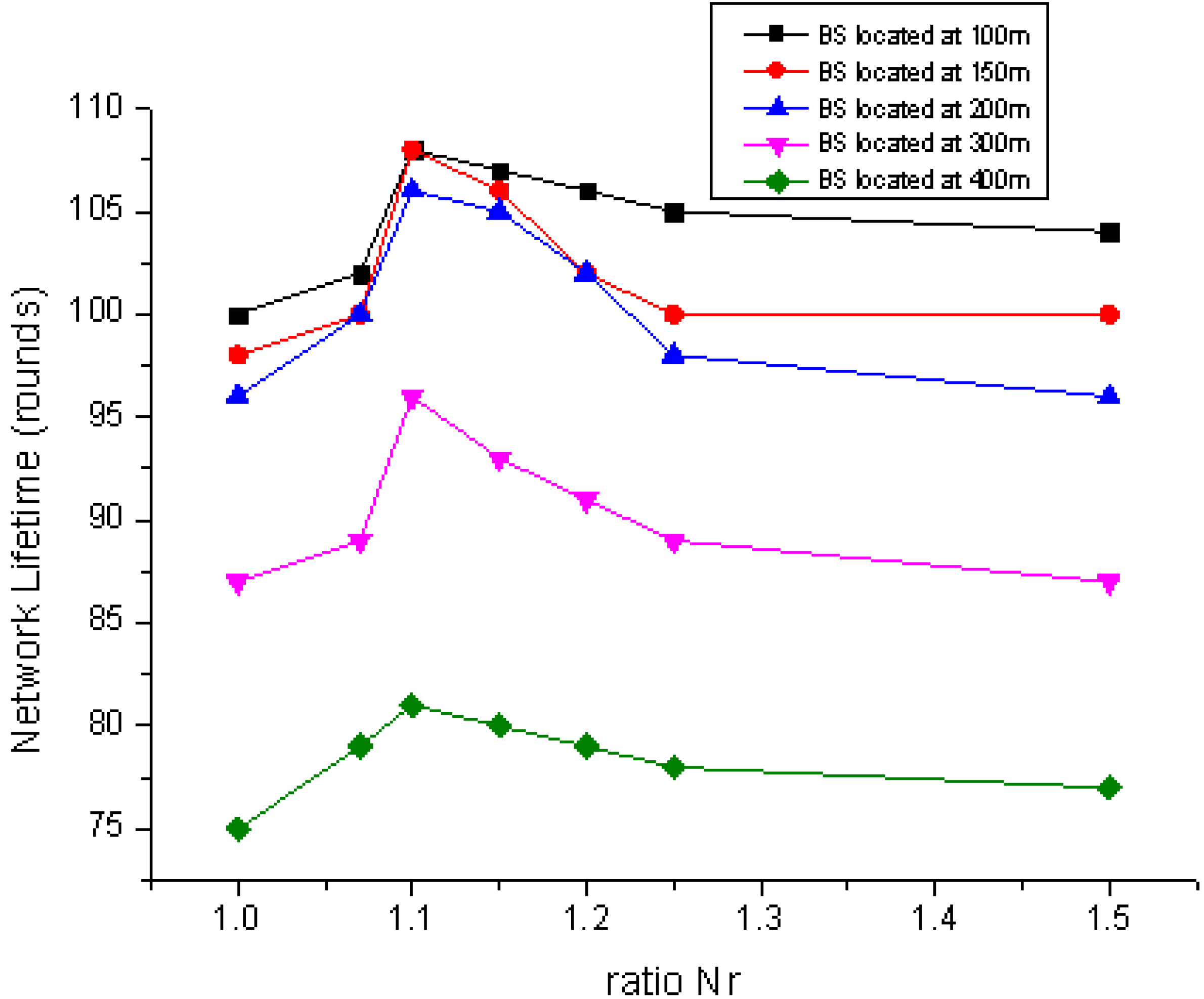
| Distance between the Base Station and the Center of the WSN Field (m) | First Node Depletion Time (%) | Last Node Depletion Time (%) | Mean Energy Consumption (%) | Compared Protocol |
|---|---|---|---|---|
| 150 | +98 | +7.5 | −25.05 | LEACH |
| 150 | +5 | +30 | −19.12 | PEGASIS |
| 150 | −10 | +16 | −17.25 | BCDCP |
| Node Ratio Nr of Nodes on upper versus Nodes on Lower Level | First Node Depletion Time (%) | Last Node Depletion Time (%) | Mean Energy Consumption (%) |
|---|---|---|---|
| 1 | - | - | - |
| 1.07 | +2 | +3.5 | −2.5 |
| 1.1 | +10 | +10 | −5.7 |
| 1.15 | +8.2 | +8 | −4.5 |
| 1.2 | +4 | +4.8 | −3.2 |
| 1.25 | +2 | +2.7 | −2.1 |
| 1.5 | +2 | +2 | −1.9 |
| Node ratio Nr of Nodes on Upper versus Nodes on Lower Level | First Node Depletion Time (%) | Last Node Depletion Time (%) | Mean Energy Consumption (%) |
|---|---|---|---|
| 1 | - | - | - |
| 1.07 | +2.1 | +3.1 | −2.2 |
| 1.1 | +10 | +10 | −5.7 |
| 1.15 | +6.8 | +7 | −3.5 |
| 1.2 | +4.9 | +4.6 | −3.2 |
| 1.25 | +2.1 | +3.1 | −2.5 |
| 1.5 | +0.1 | +1.5 | −1.5 |
5. Conclusions
References
- Akyildiz, I.F.; Su, W.; Sankarasubramaniam, Y.; Cayirci, E. Wireless sensor networks: A survey. Comput. Netw. 2002, 38, 393–422. [Google Scholar] [CrossRef]
- Yick, J.; Mukherjee, B.; Ghosal, D. Wireless sensor network survey. Comput. Netw. 2008, 52, 2292–2330. [Google Scholar] [CrossRef]
- Kandris, D.; Tsioumas, P.; Tzes, A.; Nikolakopoulos, G.; Vergados, D. Power conservation through energy efficient routing in wireless sensor networks. Sensors 2009, 9, 7320–7342. [Google Scholar] [CrossRef] [PubMed]
- Jin, Z.; Ping, Y.; Wang, Z.; Ping, L.; Guang, L. A survey on position-based routing algorithms in wireless sensor networks. Algorithms 2009, 2, 158–182. [Google Scholar] [CrossRef]
- Liao, W.; Chang, K.; Kedia, S. An Object Tracking Scheme for Wireless Sensor Networks using Data Mining Mechanism. In Proceedings of the Network Operations and Management Symposium, Maui, HI, USA, 2012; pp. 526–529.
- Tubaishat, M.; Zhuang, P.; Qi, Q.; Shang, Y. Wireless sensor networks in intelligent transportation systems. Wirel. Commun. Mob. Comput. 2009, 9, 287–315. [Google Scholar] [CrossRef]
- Wood, A.; Stankovic, J.; Virone, G.; Selavo, L.; Zhimin, H.; Qiuhua, C.; Thao, D.; Yafeng, W.; Lei, F.; Stoleru, R. Context-Aware wireless sensor networks for assisted living and residential monitoring. Network 2008, 22, 26–33. [Google Scholar] [CrossRef]
- Alemdar, A.; Ibnkahla, M. Wireless Sensor Networks: Applications and Challenges. In Proceedings of the 9th International Symposium on Signal Processing and Its Applications, Sharjah, United Arab Emirates, 2007; pp. 1–7.
- Vidhyapriya, R.; Vanathi, P. Energy Aware Routing for Wireless Sensor Networks. In Proceedings of the International Conference on Signal Processing, Communications and Networking, Chennai, India, 2007; pp. 545–550.
- Nikoletseas, S.; Spirakis, P.G. Probabilistic Distributed Algorithms for Energy Efficient Routing and Tracking in Wireless Sensor Networks. Algorithms 2009, 2, 121–157. [Google Scholar] [CrossRef]
- Heinzelman, W.; Chandrakasan, A.; Balakrishnan, H. Energy-Efficient Communication Protocol for Wireless Microsensor Networks. In Proceedings of the 33rd Hawaii International Conference on System Sciences, Hawaii, HI, USA, 2000; pp. 1–10.
- Lindsey, S.; Raghavendra, C. PEGASIS: Power-Efficient GAthering in Sensor Information Systems. In Proceedings of the IEEE Aerospace Conference, Los Angeles, MT, USA, 2000; pp. 1125–1130.
- Jung, S.; Han, Y.; Chung, T. The Concentric Clustering Scheme for Efficient Energy Consumption in the PEGASIS. In Proceedings of the 9th International Conference on Advanced Communication Technology, Gangwon-Do, Korea, 2007; pp. 260–265.
- Manjeshwar, A.; Agrawal, D. Teen: A Routing Protocol for Enhanced Efficiency in Wireless Sensor Networks. In Proceedings of the 15th International Parallel and Distributed Processing Symposium (IPDPS’01) Workshops, San Francisco, CA, USA, 2001; pp. 2009–2015.
- Yang, Y.; Wu, H.; Chen, H. SHORT: Shortest Hop Routing Tree for Wireless Sensor Networks. In Proceedings of the IEEE International Conference on Communications, Istanbul, Turkey, 2006; pp. 3450–3454.
- Lotf, J.; Bonab, M.; Khorsandi, S. A Novel Cluster-based Routing Protocol with Extending Lifetime for Wireless Sensor Networks. In Proceedings of the 5th International Conference on Wireless and Optical Communications Networks, Surabaya, India, 2008; pp. 1–5.
- Allirani, A.; Suganthi, M. An Energy Efficient Cluster Formation Protocol with Low Latency In Wireless Sensor Networks. World Acad. Sci., Eng. Tech. 2009, 51, 1–7. [Google Scholar]
- Muruganathan, S.; Ma, D.; Bhasin, R.; Fapojuwo, A. A Centralized Energy-Efficient Routing Protocol for Wireless Sensor Networks. IEEE Radio Commun. 2005, 43, 8–13. [Google Scholar] [CrossRef]
© 2013 by the authors; licensee MDPI, Basel, Switzerland. This article is an open access article distributed under the terms and conditions of the Creative Commons Attribution license (http://creativecommons.org/licenses/by/3.0/).
Share and Cite
Nikolidakis, S.A.; Kandris, D.; Vergados, D.D.; Douligeris, C. Energy Efficient Routing in Wireless Sensor Networks Through Balanced Clustering. Algorithms 2013, 6, 29-42. https://doi.org/10.3390/a6010029
Nikolidakis SA, Kandris D, Vergados DD, Douligeris C. Energy Efficient Routing in Wireless Sensor Networks Through Balanced Clustering. Algorithms. 2013; 6(1):29-42. https://doi.org/10.3390/a6010029
Chicago/Turabian StyleNikolidakis, Stefanos A., Dionisis Kandris, Dimitrios D. Vergados, and Christos Douligeris. 2013. "Energy Efficient Routing in Wireless Sensor Networks Through Balanced Clustering" Algorithms 6, no. 1: 29-42. https://doi.org/10.3390/a6010029
APA StyleNikolidakis, S. A., Kandris, D., Vergados, D. D., & Douligeris, C. (2013). Energy Efficient Routing in Wireless Sensor Networks Through Balanced Clustering. Algorithms, 6(1), 29-42. https://doi.org/10.3390/a6010029






